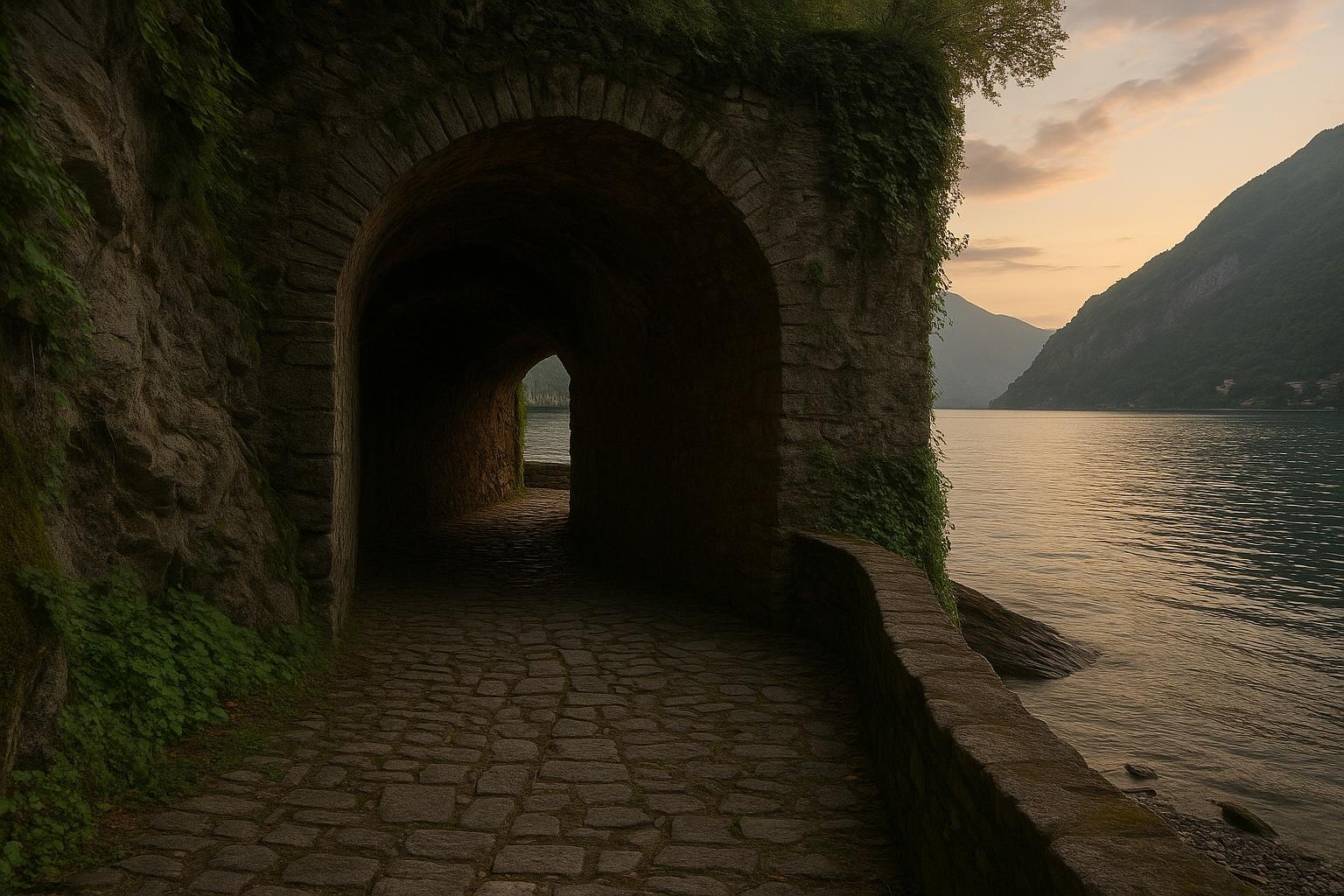Lake Como is famous for its dazzling surface—the way sunlight dances on the water, the elegant villas along its shores, the mountains rising steeply above. Yet beneath the surface and behind the facades lies another world, one that few visitors ever see. Hidden tunnels, forgotten caves, and underground passages tell a story of defense, survival, and mystery. To explore this side of the lake is to discover that Como’s beauty is not only about what shines in the open, but also about what lingers in the shadows.
Tunnels of history
The medieval city of Como was built not just to impress, but also to defend. Beneath some of its palaces and ancient walls, tunnels once connected strategic points, allowing soldiers and merchants to move unseen. Many of these passages are closed today, sealed for safety, but local historians still speak of routes linking the Cathedral area to hidden exits along the walls. Some believe these tunnels were used during sieges, offering escape routes or ways to bring supplies into the city.
Later, during the 20th century, tunnels gained new importance. As Europe plunged into the turmoil of World War II, shelters and underground galleries were carved into the mountainsides. In Como itself, several air-raid shelters were built beneath schools, factories, and civic buildings. Some remain preserved, silent reminders of nights when sirens forced entire families to wait in darkness while bombers flew overhead.
The caves of the mountains
Lake Como is also surrounded by limestone mountains, where nature itself has carved labyrinths of stone. Near Lecco and the Grigne, the landscape is riddled with caves formed by centuries of water erosion. These caves were known to shepherds and sometimes feared by locals, who filled them with legends. Some were said to be hiding places for bandits, others entrances to realms of spirits.
In the area of Nesso, with its famous gorge and waterfall, smaller caves open dramatically along the cliffs. They are rarely accessible, but their presence adds to the sense that the lake conceals secrets in its depths. Divers occasionally explore underwater caves along the shoreline, revealing chambers where time seems frozen, decorated with stalactites invisible to those who remain on the surface.
Forgotten wartime shelters
One of the most striking parts of Lake Como’s underground history is its role in the Second World War. Along the western shore, especially in Tremezzina and Dongo, caves and tunnels were adapted into shelters or used by partisans. In some villages, old wine cellars doubled as hiding places for families during raids. Oral traditions keep alive stories of people waiting in silence, listening to the distant echo of fighting.
In Dongo, where Mussolini was captured in 1945, basements and storage vaults of lakeside palaces became temporary prisons. Many of these underground rooms are closed today, but the memory of what happened there lingers like a shadow beneath the tourist cafés and promenades.
Passages of silk and trade
Como’s reputation as a silk capital also left its mark underground. In certain parts of the old town, basements were adapted to store raw silk, keeping it cool and safe from humidity. Merchants valued these underground spaces as much as their grand shops above. Though often forgotten, these cellars were part of the machinery that made Como wealthy and famous across Europe. Some have been restored and turned into modern boutiques or wine bars, where stone vaults remind visitors of centuries of trade.
Myths and legends
Not all underground stories are factual. Folklore abounds with tales of tunnels linking monasteries, villas, and castles. Locals in Brunate whisper of passages that connect the hilltop village to Como below, though no one has proven their existence. In Cernobbio, children once told stories of a “secret road” under Villa Erba, imagined as a passage to the lake itself. Legends often exaggerate, but they reveal how strongly the idea of a hidden network fascinates the imagination.
What can be seen today
For those who wish to experience Lake Como’s underground world, a few sites are accessible. In Como city, some old air-raid shelters are occasionally open during guided tours or cultural events, allowing visitors to step inside spaces preserved almost as they were left. In Lecco and the Grigne mountains, speleological associations organize visits to natural caves, offering a glimpse into geological wonders shaped over millennia. Wine bars and restaurants in the old town sometimes reveal restored basements with vaulted ceilings, where guests can drink a glass of local red surrounded by history.
Even when places are not physically open, simply knowing they exist adds depth to a walk through the city or along the lake. Passing a heavy wooden door or a stone archway, one can imagine the networks beneath, the lives that unfolded in darkness, the secrets carried by silence.
A lake of two faces
Lake Como has always been a place of contrasts—light and shadow, water and stone, surface and depth. Its underground world may not shine like its villas or sparkle like its waters, but it holds a fascination of its own. To think of tunnels under the streets, caves inside the mountains, and forgotten shelters carved in stone is to realize that the lake is layered, both literally and metaphorically.
Exploring these hidden places is not always possible, but imagining them enriches the experience of the lake. It reminds us that beauty here is not only what can be seen in sunlight, but also what lingers quietly below, waiting in the dark.




